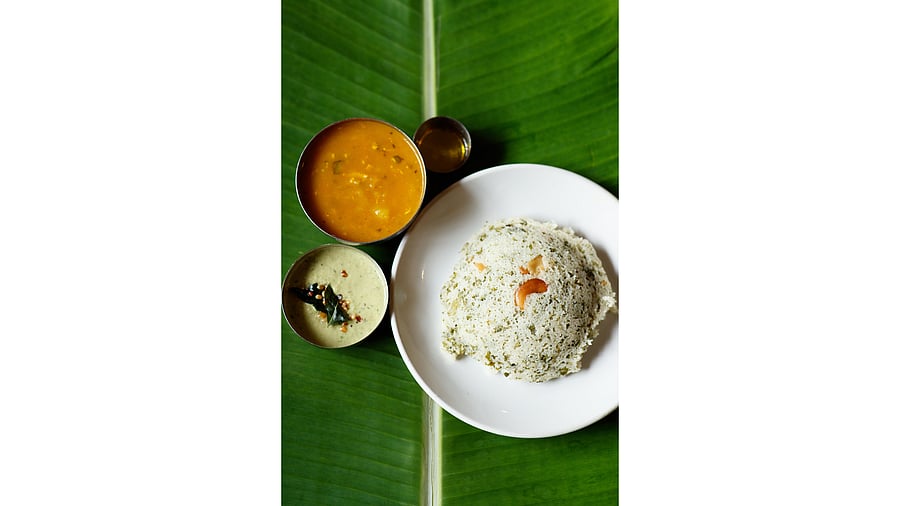
Rava idli, chutney, saagu, and thuppa (ghee) at MTR.
Pic courtesy: Tanushree Bhasin
By Pratima Chabbi
“The kharabhath (roasted and cooked semolina with vegetables, curry leaves and spices) was my first taste of MTR, 45 years back,” said Ganesh after a server laid the plates in front of us. “Thini, thini, bisi ide,” (Eat it, it’s hot), he added, smiling ear to ear. In a grey-and-white checked shirt, he was willowy, his hair blending equal measures of black and white. We sat across each other at an eight-seater dining table in the deluxe room on the first floor. Ganesh was born in Udupi but lived in Andhra Pradesh for a while, where his father ran a hotel. They eventually returned to Parampalli, where Ganesh helped his father tend their land. Ganesh, who is the operations head at MTR Lalbagh, and Harishchandra Maiya were first cousins. (Ganesh’s father and Harishchandra’s mother were siblings). One evening, Ganesh’s mother approached Harishchandra Maiya, seeking an opportunity for her son to join their family business. Without hesitation, Harishchandra agreed, and Ganesh joined MTR two days later. Ganesh spent the first two years at MTR as a server and cook and then worked as a cashier for 22 years. Forty-five years later, Ganesh is described by staff and customers alike as the “soul” of MTR. He manages every aspect of the hotel, and his personality is reflected in everything, from the kitchen to the service area. He is known to have a unique managerial style that works wonders in the daily functioning of the hotel.
The perfect Kharabhath experience
The aroma of thuppa (ghee) hit me first. As I took a bite of the soft brown mound of roasted rava (semolina), tiny bits of carrot cashew, curry leaves, uddin bele (urad dal), kadle bele (Bengal gram) and slivers of ginger unleashed a wave of flavour in my mouth. I kept aside the garnish, a roundel of freshly sliced tomato. “Great kharabhath is the perfect combination of a few key things — roasting the rava to the right amount, knowing how long to boil it in water and cooking the spices and vegetables just enough so they don’t lose their crunch. All credit goes to Yagnanarayana, who came up with the idea of garnishing it with a tomato slice. It’s one of our highest-selling dishes. All the seven items from our 1924 menu — rice idli, uddin vade, kharabhath, kesaribhath, masala/plain dose and filter coffee —remain the most loved dishes even today,” said Ganesh.
Origins of culinary mastery
I wondered where Ganappaiah and Parameshwara learnt to cook these dishes. Did they cook at home in Parampalli? “They didn’t learn to cook at home,” Ganesh explained. “They picked up their culinary skills when they started working as cooks in the homes of affluent farmers in Thirthahalli. Once they moved to Bangalore, Parameshwara found work in a hotel, and Ganappaiah continued as a cook in a businessman’s house. This experience would come in handy when they later established MTR.”
MTR’s first menu, a modest ensemble of just seven dishes, bore the imprint of their collective experiences. It blended the warmth of Thirthahalli’s home-cooked food with the cosmopolitan culinary scene in Bangalore. The hotel was open from 6.30 am to 11 am and then again from 3.30 pm to 7.30 pm. Everything was available until they ran out. “Why did they serve only seven dishes?” I nudged.
“Parameshwara and Ganappaiah believed too many options were wasteful and a threat to consistent, quality food. In fact, food left over after service was not thrown away. The leftover food was first served to the team, and what remained was left on the compound walls for the poor to take free of cost,” replied Ganesh. MTR believed that such acts of service curbed wastefulness, fostered a sense of community with the locals, and encouraged inclusiveness among the employees.
In 1924, MTR’s menu reflected a combination of values: a dedication to quality, a family ethos shaped by their upbringing, where scarcity instilled a strong aversion to waste, and a deep respect for the labour of those who grew food. These values are beautifully encapsulated in Ganappaiah’s words to his children: “Who grows the food you eat? Think about their struggles. When you eat, remember the farmer who grew your food.” Ganesh continued, “The menu remained unchanged for almost 16 years, until about 1940. During the Second World War, MTR faced a crisis as the rice supply dwindled considerably. Eventually, we could not cook our staple and top-selling dish, the rice idli.”
The decisions made by Winston Churchill’s wartime cabinet in London during this time led to an extensive utilisation of Indian resources for the war effort. Despite the dire consequences to India, the British government continued exporting rice to other parts of the empire. This practice persisted even as urgent pleas from India’s viceroy for over 1 million tonnes of emergency wheat supplies in 1942–43 went unanswered by London. The prioritisation of imperial interests over the critical needs of the Indian population marked a challenging chapter in the history of India. South India was not a wheat-eating region. Naturally, this was a significant challenge for MTR.
“Yagnanarayana decided to experiment. He added sour curd to the rava and as it bubbled, he added water. He steamed this batter in an idli steamer, and out came rava idli!” Ganesh added. I was stunned by his genius. Evidently, no one knows how Yagnanarayana developed the formula. MTR’s rava idli, like a lot of food in India, was the result of jugaad (enterprisingness) in the face of adversity.
(An exclusive excerpt from the self-published book The MTR Story: A Labour of Love by Pratima Chabbi.)